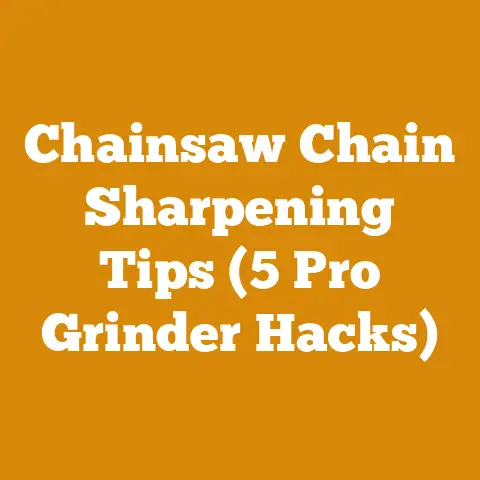Build a Door Jamb Guide (5 Expert Tips for Perfect Wood Joinery)
I’ll never forget the time I tried to hang a new door in my old workshop.
I was so eager to replace the drafty, warped thing that had been letting in winter winds for years.
I rushed the job, thinking I could eyeball the door jamb.
Big mistake.
The door swung open like a saloon door in a Western movie, and the gap along the top was wide enough to slip a dollar bill through.
So, let’s dive into the art of building a perfect door jamb guide.
The global wood processing industry is a powerhouse, with a market size estimated at over $700 billion USD and growing steadily.
A significant portion of this industry focuses on producing lumber for construction, including the essential components like door jambs.
In North America alone, the demand for softwood lumber, commonly used for door jambs, is expected to reach over 60 billion board feet in the coming years.
This highlights the importance of understanding proper wood joinery techniques for both professionals and DIY enthusiasts.
Understanding the Importance of a Perfect Door Jamb
A door jamb is more than just a frame; it’s the backbone of your door system.
It provides structural support, ensures the door hangs correctly, and seals the opening against drafts and noise.
A poorly constructed jamb can lead to a host of problems, from doors that stick and don’t latch properly to air leaks that increase energy costs.
Key Concepts:
- Door Jamb: The vertical and horizontal framing members that surround a door opening.
- Wood Joinery: The techniques used to connect pieces of wood together to create a strong and aesthetically pleasing joint.
- Squareness: Ensuring that corners are perfectly 90 degrees, crucial for a properly functioning door.
- Plumb: Ensuring that vertical elements are perfectly vertical, essential for door alignment.
Building a Door Jamb Guide: 5 Expert Tips for Perfect Wood Joinery
Here are five expert tips to help you build a door jamb that is not only functional but also a testament to your woodworking skills.
Tip 1: Precise Measurements and Material Selection
The foundation of any successful woodworking project is accurate measurements and the right materials.
Taking Accurate Measurements
Before you even think about cutting wood, meticulously measure the door opening.
Measure the width at the top, middle, and bottom of the opening.
Use the narrowest measurement as your guide.
Similarly, measure the height on both sides of the opening, using the shorter measurement.
- Why is this important? Walls are rarely perfectly square or plumb.
Taking multiple measurements ensures you account for any imperfections. - Data Point: A study by the National Association of Home Builders found that over 60% of door installation issues are due to inaccurate measurements.
Selecting the Right Wood
The choice of wood is crucial for the longevity and performance of your door jamb.
Softwoods like pine and fir are commonly used due to their workability and affordability.
However, hardwoods like oak or maple offer greater durability and resistance to wear and tear.
- Pine: Easy to work with, accepts paint and stain well, but is prone to dents and scratches.
- Fir: Similar to pine but slightly more resistant to moisture.
- Oak: Highly durable, resistant to warping, but more challenging to work with and more expensive.
- Maple: Very strong and stable, but can be difficult to stain evenly.
My Story: I once used reclaimed barn wood for a door jamb, thinking it would add character.
While it looked fantastic, the wood was full of hidden nails and inconsistencies, making it a nightmare to work with.
I learned that sometimes, new, properly milled lumber is the better choice.
Actionable Tip: When selecting wood, check for straightness, absence of knots, and consistent grain.
Use a moisture meter to ensure the wood is properly dried (ideally between 6% and 8% moisture content).
Tip 2: Cutting with Precision
Accurate cuts are essential for tight-fitting joints and a square door jamb.
Using the Right Tools
- Miter Saw: Ideal for making precise angle and square cuts.
- Table Saw: Excellent for ripping lumber to the correct width.
- Hand Saw: Useful for fine-tuning cuts and working in tight spaces.
- Chisels: Essential for cleaning up joints and creating mortises.
Data Point: A survey of professional carpenters revealed that a high-quality miter saw can improve cutting accuracy by up to 30%.
Making Square Cuts
Use a speed square or combination square to ensure your cuts are perfectly square.
When using a miter saw, double-check the blade angle before each cut.
Step-by-Step Guide:
- Mark the cut line: Use a sharp pencil and a square to mark the cut line accurately.
- Position the wood: Place the wood firmly against the fence of the miter saw.
- Lower the blade: Slowly lower the blade to the wood, aligning it with the cut line.
- Make the cut: Engage the saw and smoothly cut through the wood.
Troubleshooting: If your cuts are not square, check the blade angle of your miter saw or table saw.
Also, ensure the fence is square to the blade.
Ripping Lumber
When ripping lumber to the correct width, use a table saw with a sharp blade.
Use a push stick to safely guide the wood through the saw.
Safety First: Always wear safety glasses and hearing protection when using power tools.
Real Example: I once watched a carpenter meticulously adjust his table saw fence before ripping a piece of lumber.
He explained that even a slight misalignment could throw off the entire project.
His attention to detail resulted in a perfectly sized jamb member.
Tip 3: Mastering Wood Joinery Techniques
The strength and stability of your door jamb depend on the quality of your wood joints.
Here are a few essential techniques:
Mortise and Tenon Joints
Mortise and tenon joints are incredibly strong and durable, making them ideal for door jambs.
A mortise is a hole cut into one piece of wood, and a tenon is a protruding piece of wood that fits into the mortise.
Step-by-Step Guide:
- Mark the mortise: Use a mortise gauge to mark the dimensions of the mortise on the jamb member.
- Cut the mortise: Use a mortising machine, drill press, or chisels to remove the wood from the mortise.
- Mark the tenon: Use a tenon saw or table saw to cut the tenon on the stile member.
- Fit the tenon: Test the fit of the tenon in the mortise.
It should be snug but not too tight. - Glue and clamp: Apply glue to the mortise and tenon and clamp the joint until the glue dries.
Unique Insight: When cutting mortise and tenon joints, it’s better to err on the side of a slightly loose fit.
You can always shim the joint with thin pieces of wood, but a joint that’s too tight can be difficult to assemble.
Half-Lap Joints
Half-lap joints are simpler to create than mortise and tenon joints but still provide excellent strength.
In a half-lap joint, half of the thickness of each piece of wood is removed, allowing them to overlap and create a flush surface.
Step-by-Step Guide:
- Mark the cut lines: Use a marking gauge to mark the areas to be removed on each piece of wood.
- Cut the laps: Use a saw to make multiple cuts within the marked areas.
- Remove the waste: Use a chisel to remove the waste wood and create a flat surface.
- Test the fit: Ensure the two pieces of wood fit together snugly and create a flush surface.
- Glue and clamp: Apply glue to the joint and clamp until the glue dries.
Data Point: Studies have shown that properly executed half-lap joints can withstand up to 75% of the strength of the wood itself.
Pocket Hole Joints
Pocket hole joints are a quick and easy way to join wood, especially for beginners.
These joints use angled screws driven into pre-drilled holes.
Step-by-Step Guide:
- Drill the pocket holes: Use a pocket hole jig to drill the angled holes in the back of one piece of wood.
- Clamp the pieces together: Align the two pieces of wood and clamp them securely.
- Drive the screws: Use a drill or impact driver to drive the screws into the pocket holes.
Actionable Tip: When using pocket hole joints, choose the correct screw length for the thickness of the wood.
Using screws that are too long can cause them to protrude through the surface.
Tip 4: Assembling the Door Jamb
With the joints prepared, it’s time to assemble the door jamb.
Dry Fitting
Before applying glue, dry-fit all the pieces of the door jamb to ensure they fit together properly.
This is your last chance to make any adjustments or corrections.
My Experience: I once skipped the dry-fitting step and ended up with a door jamb that was slightly out of square.
It took me hours to disassemble the joint and make the necessary corrections.
Applying Glue
Use a high-quality wood glue that is appropriate for the type of wood you are using.
Apply the glue evenly to all surfaces of the joint.
Glue Types:
- Polyurethane Glue: Strong and waterproof, ideal for exterior applications.
- PVA Glue (Wood Glue): Good for interior applications, easy to clean up with water.
- Epoxy: Extremely strong and durable, but more difficult to work with.
Clamping
Clamping is essential for ensuring a strong and tight bond between the pieces of wood.
Use clamps to apply even pressure to the joints.
Clamping Techniques:
- Bar Clamps: Ideal for clamping long pieces of wood.
- Pipe Clamps: Similar to bar clamps but can be extended to longer lengths.
- Corner Clamps: Useful for clamping corners at a 90-degree angle.
Data Point: Studies have shown that proper clamping can increase the strength of a glued joint by up to 50%.
Actionable Tip: Use wax paper or plastic sheeting between the clamps and the wood to prevent the clamps from sticking to the glue.
Checking for Squareness and Plumb
As you clamp the door jamb together, continuously check for squareness and plumb.
Use a square to ensure the corners are 90 degrees, and use a level to ensure the jamb is plumb.
Troubleshooting: If the door jamb is not square, adjust the clamps until it is.
You can also use shims to correct any minor imperfections.
Tip 5: Installation and Finishing
Once the door jamb is assembled, it’s time to install it in the door opening and apply the finishing touches.
Preparing the Opening
Before installing the door jamb, ensure the door opening is clean and free of debris.
Check the opening for squareness and plumb.
Actionable Tip: Use shims to correct any imperfections in the door opening.
Place the shims behind the door jamb to ensure it is perfectly plumb and square.
Installing the Jamb
Carefully lift the door jamb into the opening and position it correctly.
Use shims to hold it in place.
Step-by-Step Guide:
- Position the jamb: Place the door jamb in the opening, ensuring it is centered.
- Shim the jamb: Use shims to adjust the jamb until it is perfectly plumb and square.
- Secure the jamb: Use screws or nails to secure the jamb to the wall studs.
Safety First: Always wear safety glasses when using power tools.
Finishing Touches
Once the door jamb is installed, fill any nail holes or imperfections with wood filler.
Sand the jamb smooth and apply a primer and paint or stain.
Finishing Options:
- Paint: Provides a durable and easy-to-clean finish.
- Stain: Enhances the natural beauty of the wood.
- Varnish: Provides a clear, protective finish.
My Story: I once spent hours meticulously sanding and finishing a door jamb, only to discover a small scratch after I had applied the final coat of varnish.
I had to sand the entire jamb again and reapply the varnish.
I learned that it’s always better to double-check your work before applying the finish.
Unique Insight: When applying paint or stain, use multiple thin coats rather than one thick coat.
This will result in a smoother, more even finish.
Additional Considerations
Cost and Budgeting
Building a door jamb can be a cost-effective alternative to buying a pre-made one.
However, it’s important to consider the cost of materials, tools, and your time.
Cost Breakdown:
- Lumber: $20 – $50 per jamb
- Glue: $10 – $20
- Screws/Nails: $5 – $10
- Finishing Materials: $10 – $20
Budgeting Tips:
- Shop around for the best prices on lumber.
- Consider using reclaimed lumber to save money.
- Rent tools instead of buying them if you only need them for a single project.
Resource Management
Efficient resource management is crucial for minimizing waste and maximizing your investment.
Resource Management Tips:
- Plan your cuts carefully to minimize waste.
- Use scrap wood for smaller projects.
- Recycle or donate any leftover materials.
Troubleshooting Common Issues
- Door Jamb is Not Square: Adjust the clamps or use shims to correct the squareness.
- Door Sticks or Rubs: Check the alignment of the door and jamb.
Adjust the hinges or use a plane to remove any excess material. - Air Leaks: Seal any gaps between the door and jamb with weather stripping.
Next Steps and Additional Resources
Now that you’ve learned how to build a perfect door jamb, here are some next steps and additional resources to help you further your woodworking skills:
- Practice: The best way to improve your woodworking skills is to practice.
Start with simple projects and gradually work your way up to more complex ones. - Take a Class: Consider taking a woodworking class at a local community college or vocational school.
- Join a Woodworking Club: Connect with other woodworkers and share your knowledge and experiences.
- Online Resources: Explore online forums, blogs, and video tutorials to learn new techniques and tips.
Suppliers of Logging Tools and Drying Equipment:
- Chainsaw Suppliers: Stihl, Husqvarna, Echo
- Logging Tool Suppliers: Bailey’s, Forestry Suppliers
- Drying Equipment Rental Services: Sunbelt Rentals, United Rentals
In the world of woodworking, patience is a virtue, and precision is the name of the game.
By following these expert tips, you’ll be well on your way to building door jambs that are not only functional but also a source of pride.
So grab your tools, select your wood, and get ready to create something beautiful and lasting.
Remember, every master was once a beginner, and with dedication and practice, you can achieve woodworking greatness.






